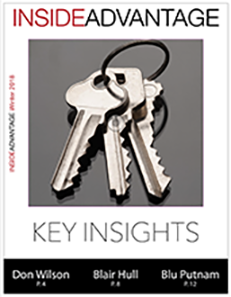Interview with
Rick Beaman Vice President, Nasdaq, Head of Nasdaq Futures Exchange
Rob Finnegan, Co-Founding Partner, Tethys Group
Advantage: NFX appears to have really gained some traction. How long have you been around and what is your average volume as a percent of total energy business?
Rick Beaman: NFX launched on July 24, 2015, and has experienced growth every quarter since—in volume, open interest and new firms onboarding. We currently average about 4% to 6% of overall energy market share with several products upwards of 15% market share on a daily basis.
Advantage: Where do you see your market share heading over the next year or two?
Rick: We expect growth to continue in volume as well as in open interest and aim to have 10% market share by the end of this year.
Advantage: The past several months it seems as though your open interest has also increased. How is that metric doing?
Rick: We experienced significant growth in open interest with Q1 2017 increasing by 65% over Q4 2016. Nat Gas and Power led the way—currently at 2.25 million contracts in open interest.
Advantage: How do NFX exchange fees compare with other exchanges offering similar products?
Rick: NFX offers transparent pricing and volumetric fee tiers to provide clients competitive rates across the board. Our goal is to offer clients up to a 50% reduction in fees compared to competitors’ published rates.
Advantage: Exchange fees remain a factor traders must consider. NFX priced energy products very aggressively. Now that NFX has established market share, does the exchange intend to stay focused on aggressive pricing or adopt the pricing models similar to those in place before NFX entered the marketplace?
Rick: NFX has gradually phased in pricing over time. We recently transitioned to our upper level target pricing on most products and do not currently intend to raise rates from these levels. We also introduced a competitive tiered fee structure which can lower rates on a firm wide level.
Advantage: Why should a client trade on NFX instead of another exchange?
Rick: NFX offers competitive exchange and clearing rates up to 50% less than published rates of the incumbent exchanges. These rates are fully transparent, available to all participants and accompanied by volumetric tier discounts which can further lower fees.
Rob Finnegan: It’s simple: Pricing. For most traders and firms, fees are a significant contributor to the bottom line of a trading book. As NFX continues to grow, you see the exact same markets and quotes as other exchanges but pay a dramatic difference in fees.
Advantage: Of all the markets you could enter, why energy?
Rick: NFX believes the energy markets are ripe for competition. In other markets and sectors, competition has a positive impact by reducing clearing and brokerage fees in addition to ISV (independent software vendor) costs. The two cost factors not impacted by competition are energy trading and clearing fees—until now. The trading community sees this and it has seeded demand for an alternative offering.
Advantage: Where is NFX getting the most traction? In the U.S., Europe, Asia?
Rick: We are seeing the most traction in the U.S. and, depending on the product line, in Europe. We also saw tremendous outreach from Asia recently. It seems clients in Asia are experiencing pressure on their margins due to increased fees, such as market data fees, and expressed a lot of interest in NFX’s cost effective offering.
Advantage: What types of clients are contributing to your volume growth?
Rick: Our founding participant group has been tremendous in contributing to our initial growth. This group is comprised of several of the world’s largest banks, hedge funds, market makers, FCMs, utilities and physical players. The founding participant group allowed us to attract other market participants. We now see more utilities, hedge funds and oil majors contributing significant volume.
Advantage: Where is the NFX matching engine located?
Rick: The NFX matching engine is located in Chicago at the Cermak data center (CH4).
Advantage: What percent of trading are block trades?
Rick: Early on we saw a majority of trades being blocked; however, as our screen presence increases, we see the majority of our overall volumes transact there. Approximately 20% of a given day’s trades are currently block trades.
Advantage: How many and what ISVs have written to NFX?
Rick: We work with the leading independent software vendors through our Preferred Vendor Program. More details on the program and vendor list can be found here:
http://business.nasdaq.com/nasdaq-futures/vendors
Advantage: Do you plan to develop your own order entry system for non-block trades?
Rick: Not at this time. Feedback from the marketplace favors increased efficiency through ISV platforms that can aggregate prices across markets. If a trader sees the same bids and offers on competitor exchanges, they can transact on the exchange with lower fees.
Advantage: Are there any membership categories?
Rick: We do not have any membership categories or price differentiation. Our approach is transparent and provides clients the same access to volume based tiers regardless of the trading firm’s category, size or geographic location.
Advantage: Do you anticipate expanding into any other types of markets in the next year or two?
Rick: Yes. We have a number of product launches planned this year related to energy and will expand into new commodity and financial assets classes in the second half of this year. We will provide further details about these products in the coming months.
Advantage: Since launch, what surprised you the most at NFX?
Rob: Prior to launch, we all had great expectations for the success of the exchange. I am surprised most by the continued steady increase in liquidity and open interest—well beyond the growth forecast. It proves the demand for a competitive, fairly priced energy exchange.
Rick Beaman is Vice President of Nasdaq and Head of the Nasdaq Futures Exchange (NFX), and Client and Broker Relations for U.S. Commodities. Based in Houston, TX, Mr. Beaman oversees all business activities for NFX and Client and Broker relations for U.S. Commodities. Mr. Beaman joined Nasdaq in May 2010 and has been involved in the Exchange, Clearing, Product Development and Brokering of Energy Markets for more than 15 years. Rick is also a 10-year veteran of the U.S. Navy.
Mr. Finnegan is co-founding partner of the Tethys Group of companies. Founded in 2013, Tethys has grown into a highly respected, multibillion-dollar revenue trading company. Prior to Tethys, Mr. Finnegan was a member of BP’s distillate trading book responsible for the US Gulf Coast, Atlantic Coast and Caribbean Import/Export Operations Programs. Mr. Finnegan served as a member of BP’s Integrated Supply & Trading Global Marine Board of Advisors. He also was a member of the Global Commercial Shipping team. Mr. Finnegan previously served as Chief Officer for Global Industries on-board the MSV Orion. He served and retired as a LT in the U.S. Naval Reserve and received a B.S. in Logistics and Intermodal Transportation from the United States Merchant Marine Academy. Mr. Finnegan currently serves as the chairman of the Nasdaq Futures Exchange market advisory board and has served on the board as a member since July 2015.












